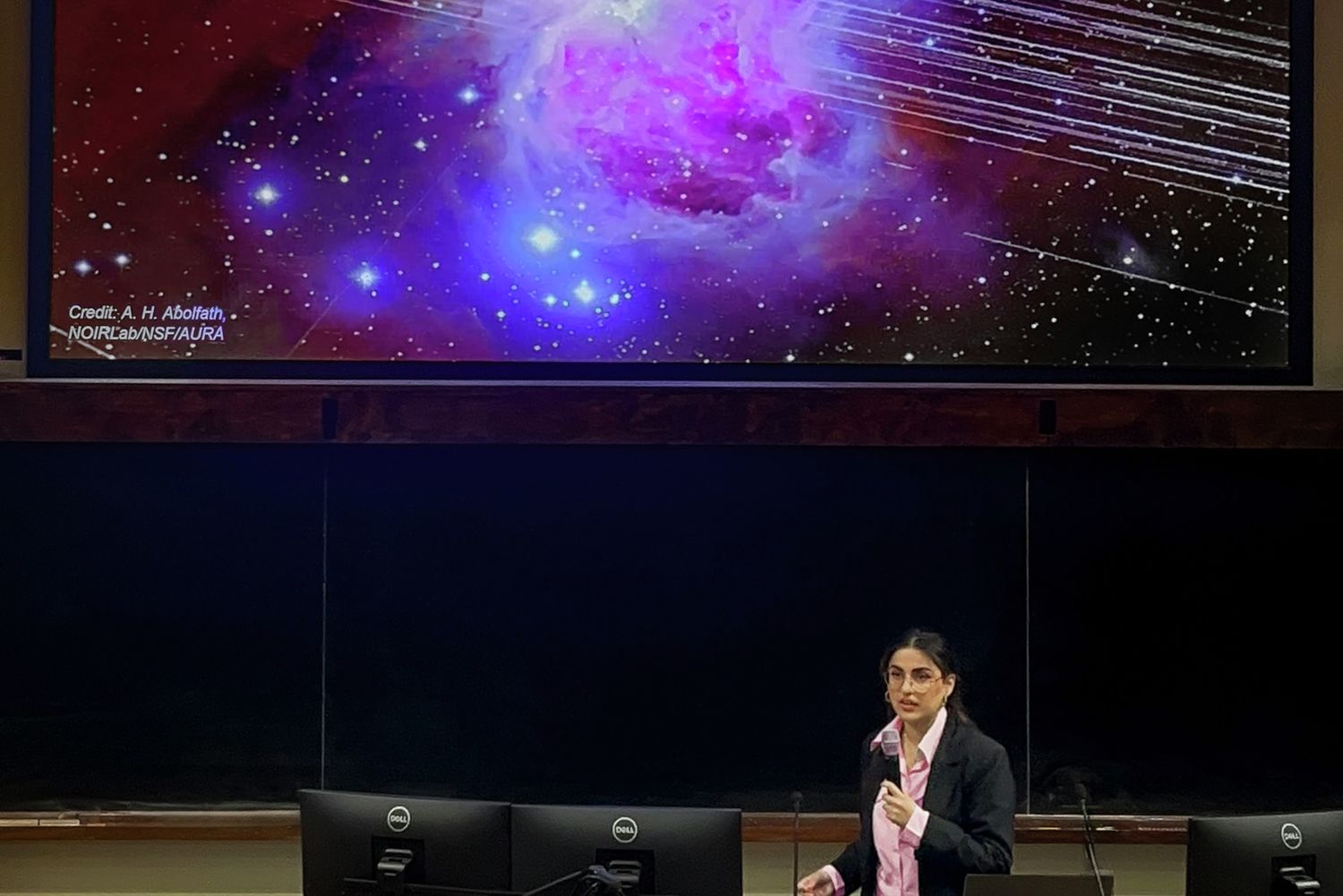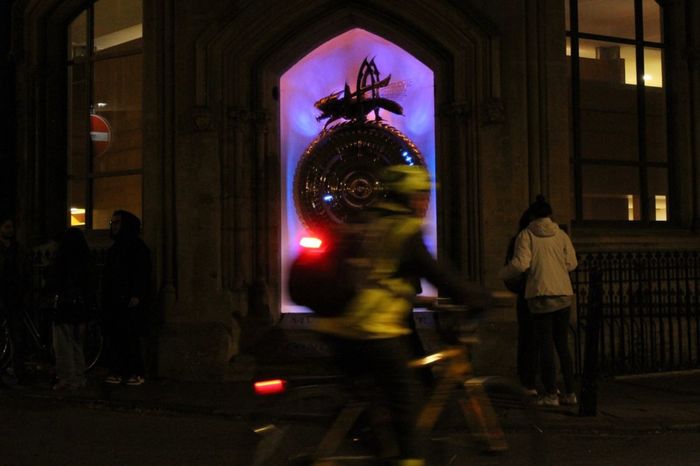What is REACH?
REACH stands for the Radio Experiment for the Analysis of Cosmic Hydrogen. It’s kind of a mouthful! I think the best way to explain it is to build up a scene: let’s go back to a time before stars, before galaxies, before anything we recognise in the Universe. This is called the Dark Ages, when the Universe was really nothing but a vast expanse of hydrogen, bathed in the afterglow of energy left from the Big Bang.
This is where everything begins, because, just like that, 13 billion years ago, [everything] spontaneously erupted and the first stars ignited, shaping the cosmos and forming the massive cosmological structures we see today – how did this transformation happen?
What radio astronomers thought was: why only spend our time coming up with theories [about this transformation]? Why don’t we just listen to the Universe? That’s why radio astronomers turned to 21cm cosmology, listening to faint cosmic radio signals that have been travelling across the Universe for billions of years, carrying a hidden record of cosmic history that could give us clues about the first stars.
“Carrying a hidden record of cosmic history that could give us clues about the first stars”
What can 21cm cosmology tell us about the Universe?
21cm cosmology is built on trying to measure the 21cm line – a radio wavelength emitted by neutral hydrogen, the most abundant element in the Universe. By tracking the changes over time, you can try and trace the timeline of the Universe from the Dark Ages to the cosmic dawn, when the first stars formed about 100 million years after the Big Bang. These are periods of the Universe that have not been directly probed or investigated. [The 21cm line] provides a tracer to understand when and how the first stars, first galaxies and even black holes formed, and how they could have influenced their surroundings.
Why does Starlink affect the measurements taken by REACH?
The 21 cm signal is a really ambitious area of research, but not short of challenges. It is a very weak and fragile signal, [and is] compound[ed by] the overwhelming noise from everything else – noise from [inside] the Milky Way, from Earth, and from our own technology like Starlink satellites. This noise is 100,000 times stronger than the 21 cm signal; we are searching for the ultimate cosmic needle in a haystack. These challenges are compounded by the rapid expansion of satellite constellations in Low Earth Orbit (LEO). The most concerning is Starlink because of the sheer numbers [of satellites involved].
Historically, astronomers have moved their experiments to rural or empty areas like mountaintops or deserts. REACH is situated in the very radio-quiet zone at the Karoo Radio Reserve in South Africa, far from cities. Now, with this emergence of satellite constellations, interference doesn’t just come from the ground – it comes from above. And unlike street lights and radio stations, satellites are everywhere all the time. But the most concerning thing about Starlink is that it’s actually doing something it wasn’t meant to do.
“The most concerning thing about Starlink is that it’s doing something it wasn’t meant to do”
Satellites are meant to send out signals for communication. These signals are [at] extremely high frequencies that [do not] have [any] overlap with the kind of frequencies that astronomers are looking for. But what we didn’t expect was that Starlink would also be leaking and emitting radio signals and other radiation [which] could be coming from all sorts of electronic circuits on board, and [the problem] is getting worse with each generation. [Astronomers] knew this was happening with first-generation satellites, but for the second generation these signals are up to 32 times stronger. It is a global crisis because once SpaceX launches these satellites, they can’t magically turn these accidental signals off.
Tell us a little bit about your work on the project in particular.
The way that I look at Starlink satellites and investigate them begins with publicly-available data. Using this, I simulate the paths and trajectories of the Starlink satellites, see which ones are flying over our experiment, and filter out those that could be popping into our data. I combine huge spectral data sets that are being collected by REACH, comb through and look to see if there is any radio-frequency interference (RFI) by plotting very beautiful ‘waterfall plots’ [to] visually pinpoint where intensities are rising. By correlation [with] Starlink flyovers I can say ‘hey, this could potentially be a Starlink satellite! ’ And [so we can] move towards mitigating it or even removing it from our data.
Are there any other planned satellite technologies that could also disrupt the signals received on Earth? What can be done about it?
It isn’t only Starlink, although they are the largest LEO constellation that we have right now – I think Amazon is looking into it, Boeing as well. Iridium Next [has] been mentioned in the papers.
I think the biggest [reason] why these problems even arise is that there is no concrete regulation. The regulations for satellites only cover intended signals. These accidental leakages and unintended signals are a kind of grey zone. Another problem is that when [companies run so-called] EMC tests to see if the electronic product doesn’t interfere with itself, they only test on individual components, not the whole spacecraft. It’s like trying to see if your car works by not checking the brakes, but checking the tires and wondering why the car is not braking. I think looking at those two aspects in a broader satellite policy system would definitely help, and of course collaborating with satellite companies as well.
“There are protected bands for radio astronomy, enforced by the UN, and they’re being violated”
What could be done, technologically speaking, to prevent this problem?
[The companies] could definitely do more. I felt like this was a joke, but they actually resorted to painting the satellites black or sticking shields on them. There are protected bands for radio astronomy that are enforced by a specialised agency managed by the UN. Those are being violated right now, and there are no repercussions for that. I think making sure those are being abided by [would be an important step].
Rightly or wrongly, some people may think that we are wasting time on this research and would much prefer the internet connectivity provided by satellites instead of dark skies. What would you say to them, why should we try and protect radioastronomy?
I think this is a really interesting question. I’ve been thinking about this a lot, actually – I’m reading a book [by Andy Lawrence] about this right now and it’s looking at the two main methods of [achieving] global access to the internet. Either we have huge, entangled optical fibres – which [are] extremely expensive and impractical – or something like LEO constellations. Unicef had a recent report saying that 60% of schoolchildren don’t have internet access. This is a tragedy, especially in the modern world where the majority of us can’t go about our days without access to Wi-Fi or cellular data. That’s why we’re not competing or trying to limit global connectivity, because we don’t believe that it should be choosing between advancing astronomy or advancing technology.
[Moreover], protecting the darkness and quietness of the skies is important for some pretty [good] reasons. It gives us the ability to track asteroids and near-Earth objects that could be colliding with us, and enables us to search for biosignatures on exoplanets. [In the book, one thing Andy Lawrence] said was that the stars and the skies are our birthright, and I very much resonate with that. I think space belongs to all of us in a sense of connection to the Universe that we should preserve.
Gabriella Rajpoot is an MPhil student working in the Radio Astronomy and Cosmology Group, led by Dr Eloy de Lera Acedo in the Cavendish Laboratory.


